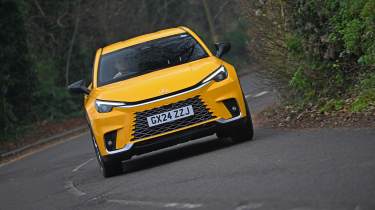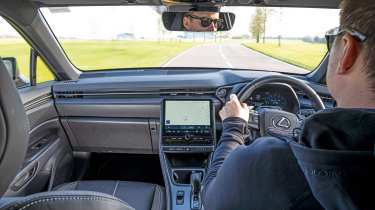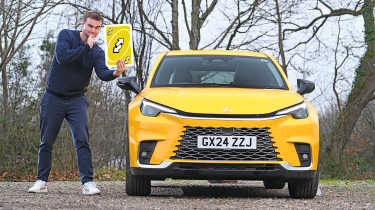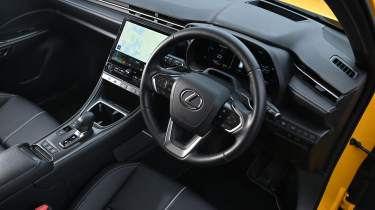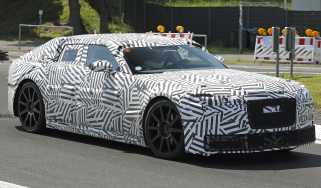Lexus LBX Takumi long-term test: premium crossover continues to impress
Third report: Onboard tech elevates the LBX, although some features falter

Verdict
Considering the building blocks Lexus worked with to create the LBX, it’s a more than reasonable outcome and one that certainly feels unique when automotive niches are far and few between. It’s easy to appreciate why the LBX is now the most popular Lexus on sale in the UK, although as we’ve seen with the implementation of technology, driving experience and price, the car hasn’t been without its niggles.
- Mileage: 6,654
- Efficiency: 47.7mpg
I was hoping that my time with the Lexus LBX would help to answer a significant question: can small cars feel premium? It sounds like a contradiction, but nonetheless the Japanese manufacturer is hoping to make a big impression with its luxury-focused compact SUV. The LBX is based on the Toyota Yaris supermini and certainly has no direct rivals from the likes of BMW, Mercedes or Volvo, and while Audi offers the A1, the baby Lexus is a little different, being classed more as a crossover.
Before I could reach a conclusion on the LBX’s premium status, the car’s odometer neared 10,000 miles – with us covering 7,398 of those – so I had to visit a dealer for the car’s first service. I booked it in with Lexus Ipswich, and an hour or so after I’d arrived, my car had a clean bill of health and I had a stomach full of coffee and biscuits.
The customer service from Lexus is legendary – it’s one of the reasons why the brand typically scores well in our Driver Power survey and keeps buyers fiercely loyal. It was no different at the Ipswich branch, where the staff were incredibly helpful and keen to hear about my experience with the LBX. The site is shared with a Toyota franchise, and although the dealership and showroom weren’t the biggest, they felt premium – much like my Lexus.
One particular feature of the LBX that helps elevate it above its Yaris cousin is the level of onboard technology. Considering the car’s size, the central touchscreen (all 12.3 inches of it) is impressive, and while I’d prefer physical controls for the climate functions, I became accustomed to the digital layout within a few days.
Other highlights include a 13-speaker Mark Levinson sound system. It’s standard on top-spec Takumi models, and with the acoustic glass and cocooning interior, audiophiles should be extremely pleased with it.
Having run the LBX over winter, my partner and I have also been particularly grateful for the heated seats and – for me at least – the heated steering wheel. Again, heated seats are not a feature you’d associate with small crossovers and superminis, but they are standard on all LBXs bar the entry-level trim.
Another bit of technology that’s standard on most versions is a wireless smartphone charger. So many manufacturers get this feature wrong, with inductive charging pads that either radiate tremendous heat, or are so shapeless that your untethered phone slides off into the footwell each time you turn into a corner – but thankfully, neither of these things happen in an LBX.
It’s not all good news, though. The powered tailgate is incredibly slow and several of my passengers have struggled with the push-button interior door handles. They can be used as a conventional pull handle, too, but in reality they’re just a needless faff.
The suite of active safety systems mostly work away quietly in the background, but there is an annoying exception: the driver monitor alert. It can be switched off, but it’s a manual process that has to be repeated every time you start the LBX. This applies to most new cars now, but is still annoying.
The head-up display and the touch-sensitive buttons that operate it initially seemed impressive, but it soon became apparent that if you accidentally brushed the touch pads on the steering wheel, it meant a large, attention-grabbing menu popped up unnecessarily.
As I’ve mentioned previously, the Lexus is a pleasant enough car to drive, with the hybrid powertrain generally doing its thing smoothly, although the groaning CVT gearbox occasionally interrupts the refinement.
Lexus LBX Takumi: third fleetwatch
Our Lexus LBX hybrid has quietly gone about its business in the past six months – especially under the 30mph threshold where it can run on its electric motor independently. It’s been a solid companion on motorway journeys and felt agile in town, but one area where it’s felt pretty mundane is on B-roads. Lexus recently whet our appetites for the LBX Morizo RR, claiming the hot crossover – which shares its powertrain with the Toyota GR Yaris – is being investigated for homologation. It got me thinking; despite how mild-mannered our small hybrid SUV has been during its time with us, I cannot wait to see how it fares as a rabid, rally-inspired performance car.
Lexus LBX Takumi: second fleetwatch
Suspension and stance help the LBX rise above Britain’s potholes
Even though SUVs seem at odds with what you would want from a ‘driver’s car’, I understand their appeal. There’s excellent visibility, a lofty driving position, the ease of jumping in and out, and the way most of them deal with Britain’s crumbling roads better than the hatches they’re based on. I’d think twice about taking a Toyota Yaris along one particular potholed lane near home, but my Lexus, with its long suspension travel and high-profile tyres, can dip a wheel in without fuss.
Lexus LBX Takumi: second report
Cool cab or rank outsider? We see how hybrid fares as a taxi
- Mileage: 4,449
- Economy: 48.6mpg
So far, the LBX has been put through its paces as a motorway cruiser, an urban runabout and even as a van of sorts. That’s given us a fair idea of its capabilities – but it’s always a sensible idea to get the opinions of our passengers, too.
So now the Lexus is entering its taxi phase. The good news is that it already has suitable paintwork – if you live in New York – so some stickers and a roof sign were all it needed. Whether it has the other defining attributes to become a viable cab remains to be seen.
I took three of my tennis team-mates to a match in Grimsby, North-East Lincs, and the trip took around three-and-a-half hours in all – plenty of time for everyone to hopefully get comfortable in Lexus’s compact crossover.
The first question I was asked about the car was how to close the boot lid. Now, if you’re a courteous taxi driver, you’ll probably open the boot for your passenger’s belongings. I’m not, and unfortunately the electric boot lid proved a headache for every one of my three pick-ups as they instinctively tried to close it manually.
But the Lexus doesn’t like it when that happens and halts proceedings, making sure you have to press the close button on the lid. A similar situation occurred when they tried to open the boot. You merely have to click the open button on the rear hatch and let it do its thing. But it’s rather slow to open and close automatically, so there’s a temptation to force it – which, infuriatingly, results in it stopping.
The next question is if the LBX is a pure-electric car, because when you set off, it naturally drives in EV-only mode. The illusion of electric running quickly dissipates though, because the throttle only needs the slightest nudge to awaken the three-cylinder petrol engine, even at very low speeds.
There were no qualms about powertrain refinement, perhaps not a surprise given that the taxi industry ran on clattery diesels for years – before the advent of quieter petrol-hybrids such as the LBX’s distant relatives, the Toyota Prius and Corolla, which started to monopolise life on the cab ranks. With two six-foot men in the back seats, I was expecting a few groans about legroom, but there wasn’t a peep out of my team-mates, so any excuses about cramping up before our game weren’t allowed. The boot was easily big enough for four large bags, too – once my passengers had closed it, of course.
Later, the focus fell on the LBX’s ‘nanoe X’ air-purification technology, because you can imagine the scent of four well-beaten tennis players and their belongings in one car. I’d already been amazed by the system when I picked up my 2ZZ engine, and just as it did then, the set-up worked wonders at fighting bad smells. It releases molecules of water through the air vents, which Lexus says deters “bad odours, acts against mould, and inhibits viruses, bacteria, pollen and allergens”. It also claims to “prevent moisture evaporation to keep skin well hydrated”.
One thing that would be a big concern if the LBX was used as a taxi, though, is its fuel consumption. Its efficiency has improved slightly of late, to 48.6mpg, which is far from terrible, but we’re still a bit surprised considering our test of a mechanically similar Toyota Yaris Cross returned 64.7mpg. The LBX’s return wouldn’t be so bad if its fuel tank wasn’t a lean 35 litres – which combined with Lexus’s conservative estimates left us scrambling for a petrol station with fewer than 10 miles of range showing, despite at least five litres remaining when we filled up.
I’m hoping an upcoming service will boost the LBX’s fuel economy, but what I’m most looking forward to is a fix for the key, because the car recently lost its keyless start function.
Lexus LBX Takumi: first fleetwatch
Our Lexus LBX shows off its practicality by swallowing a new engine destined for an Mk3 MR2
Toyota’s Yaris M Concept may have starred at the Tokyo Auto Salon last month, but before that, I had a go at creating a mid-engined Yaris (kind of). Pictured in the boot of my Yaris Cross-based Lexus LBX is a 2ZZ-GE (Toyota’s 190bhp 1.8-litre T-Sport engine). I did wonder what it would be like in the Lexus – likely not a patch on the GR Yaris’ turbocharged 1.6-litre three-cylinder in the Morizo RR concept version of the LBX. But it is a coincidence, because this 2ZZ-GE is going into an MR2 Mk3.
Lexus LBX Takumi: first report
This new compact hybrid cross pulled an UNO reverse card on us
- Mileage: 1,907
- Efficiency: 48.1mpg
Lexus decided to give its new hybrid-powered small SUV a three-letter name – which it had done only once before, with the magnificent LFA. Sorry to get your hopes up, but that’s probably the only tenuous link I’ll be able to make between our new LBX and the firm’s V10-powered supercar – but it was fun while it lasted.
The LBX is the brand’s entry-level model. In the year it’s been on sale it’s been quite the success story; it’s the best-selling Lexus overall, with 5,178 finding homes so far. The previous entry UX managed 1,297, and the evergreen NX SUV secured less than half the LBX’s total, at 2,311. With ‘LBX’ standing for ‘Lexus Breakthrough X’ (‘X’ signifying crossover), the model seems to be living up to its name.
Our example certainly creates a visual impact – the Passionate Yellow finish is incredibly vibrant in the sunshine, and somehow even more eye-catching on a dull winter’s day. It’s also the only paint that is a no-cost option, so if you want the LBX in its cheapest form (the Urban starts at £29,995) you’ll be getting a bright yellow car.
Our example, however, isn’t the base spec. It’s the Takumi, which sits behind only the top-spec Takumi Design and costs £39,555. That’s quite substantial for something which utilises a platform and powertrain from a Toyota Yaris.
So what can we expect from the LBX over the coming months? This is where things get surprising, because my preconceptions of the car have been proven completely wrong, with the Lexus going in such a different direction it may as well be an UNO reverse card.
First up is the efficiency. The Yaris majors in this area, thanks to the flexibility of the hybrid powertrain and its ability to sip fuel. I thought the LBX would impress here too, considering its ties to the Yaris; Toyota promises 68.9mpg on the combined cycle.
Lexus claims a little less for the LBX, at 61.4mpg – understandable given the extra kerb weight (1,280kg to the Yaris’s 1,090kg) and additional power (the LBX has the same 1.5-litre three-cylinder petrol hybrid, but with 134bhp rather than the supermini’s 114bhp).
Despite our best efforts, however, we’ve struggled to match this, returning 48.1mpg so far. We’ve tested efficiency in various ways, singling out motorway and urban driving without success. There is, of course, the EV-only mode – although the 1.01kWh battery is small and only works at up to 30mph.
You also have to be ultra-sensitive with the throttle to not awaken the petrol engine. Plus it’s rare that the battery and electric motor combination seems to be able to function alone, and regular ‘EV drive mode unavailable’ warnings are appearing on the dash.
Having looked at the receipt for the battery ‘state of health’ provided with the car’s registration, I found out it was rated ‘good’ with a measured voltage of 263 – between the nominal output of 201 and the system voltage of 280. If there’s no uptick in efficiency soon, I may request the services of Lexus to see whether there’s some other issue at play here.
Another preconceived idea I had about the LBX was that it wouldn’t be able to hide its Yaris underpinnings. However, while it feels similar to the Toyota in terms of power delivery (despite the slight bump in bhp),
the driving experience overall is undeniably deserving of the badge on the nose.
The LBX rides well, protects against any outside noise, and handles more neatly than its cousin from Toyota. As you’d hope, the interior is also several steps above what you would find in a Yaris. There’s a padded feel
to the leather-clad trim, nothing shakes or rattles as you go along, and everything seems incredibly well screwed together.
While admittedly the cabin does appear a little drab compared with the bright exterior, we reckon Lexus has done an amazing job in creating such a premium atmosphere from relatively humble beginnings.
| Model: | Lexus LBX Takumi (FWD) |
| Rating: | 3.5 stars |
| On fleet since: | Oct 2024 |
| Price new: | £39,555 |
| Powertrain: | 1.5-litre 3cyl petrol plus electric motor |
| Power/torque: | 134bhp/185Nm |
| CO2/BiK: | 107g/km/25% |
| Options: | None |
| Insurance*: | Group: 27 Quote: £639 |
| Mileage: | 6,654 |
| MPG: | 47.7mpg |
| Any problems? | Key not working |
*Insurance quote from AA (0800 107 0680) for a 42-year-old in Banbury, Oxon, with three points.




